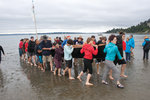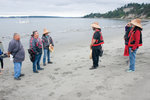The day’s weather was less than amenable for the paddlers, and at least one canoe family wound up being forced to make unscheduled stops at Protection Island and Cape George, but an estimated 10 canoes still managed to arrive on the shores of Fort Worden State Park July 17 during this year’s Canoe Journey.
This item is available in full to subscribers.
We have recently launched a new and improved website. To continue reading, you will need to either log into your subscriber account, or purchase a new subscription.
If you had an active account on our previous website, then you have an account here. Simply reset your password to regain access to your account.
If you did not have an account on our previous website, but are a current print subscriber, click here to set up your website account.
Otherwise, click here to view your options for subscribing.
* Having trouble? Call our circulation department at 360-385-2900, or email our support.
Please log in to continue |
|


The day’s weather was less than amenable for the paddlers, and at least one canoe family wound up being forced to make unscheduled stops at Protection Island and Cape George, but an estimated 10 canoes still managed to arrive on the shores of Fort Worden State Park July 17 during this year’s Canoe Journey.
The modern Canoe Journey began in 1989 when indigenous peoples of 15 nations of the Pacific Northwest Coast organized the “Paddle to Seattle” as part of Washington’s centennial celebration. Since then, it has become a regular part of summer as representatives of indigenous nations from the coast of Alaska, British Columbia and Washington travel in ocean-going canoes, visiting native nations along the way to the final host destination. Many of the canoes are made in the traditional way from a single cedar log. Protocol such as asking permission to land and sharing songs and gifts add to the cultural impact for participants.
Marlin Holden, an elder with the Jamestown S’Klallam Tribe, who helps host an average of roughly a dozen or so canoe families and support groups each year, had already anticipated a slight decline in turnout this year, due to the South Sound tribes taking a different route.
Daniel Milholland, a volunteer “puller host” for the Port Townsend landing of the annual canoe journey, reported the beach received at least 31 canoes last year, with roughly 20 tribes represented between them, from throughout the British Columbia and Washington coastlines.
“Every year, there’s a different final destination, which affects how many canoes pull ashore here in Port Townsend,” Milholland said. “Depending on that year’s destination, and what side of the Salish Sea they’re coming from, we’ve received as few as four to five canoes, and as many as 40 to 50 canoes.”
Even with fewer tribes and strong winds making the waters more difficult to navigate, Holden still expected to serve about 800 people, between the beach and the Jefferson County Fairgrounds, after crews of Port Townsend High School student athletes had helped pull the canoes ashore.
PTHS Principal Carrie Ehrhardt stood in the sand, with her camera phone in hand, to capture her kids.
“I look forward to this every year,” Ehrhardt said. “It’s a special opportunity, and we’re honored our students can be part of it.”
Ehrhardt credited Milholland with working with the student volunteers to ensure they follow proper protocols for the ceremony.
“They take their positions, but wait until they’re invited to pull the canoes ashore,” Ehrhardt said. “It ensures they’re both helpful and respectful.”
Two members of the Scia’new First Nations’ main community, on Beecher Bay in British Columbia, recounted their lifelong participation in the canoe journeys.
Tavion Charles-Henry can say he’s been doing canoe journeys literally since before he was born.
“My mom was pregnant on one of the canoe journeys, and gave birth during it,” Charles-Henry said. “One of the other ladies said to her, ‘Hey, you were pregnant just yesterday.’”
Charles-Henry turns 19 July 27, and has only missed two canoe journeys in that time.
“This is one of my favorite stops, because it’s so beautiful,” Charles-Henry said of Port Townsend. “It was a little rough making our landing this morning. It’s hard waking up, because I usually only get up early for work, but it’s rewarding when you get to your destination, after paddling the whole way.”
Charles-Henry and his fellow Beecher Bay tribal member, Michael Campbell, extolled the familial bond that develops between members of a canoe crew.
“This journey is a really big part of our culture and past, like a number of other traditions or holidays,” Campbell said. “It connects us to our ancestors, and it’s really good exercise besides.”
Indeed, given the canoe journey’s emphasis on maintaining a healthy diet, as well as its rigorously abided-by prohibitions against drug or alcohol use, Campbell feels cleansed physically as well as in spirit by the trek.
“This journey has saved a lot of lives,” Campbell said. “When you grow up rowing on the journey, you develop a lot of patience, and everyone learns to depend on each other.”